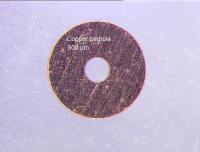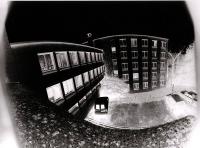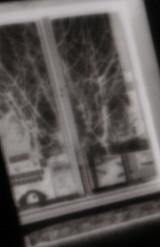Microscope diaphragms as perfects pinholes

Best quality pinhole I could find was the diaphragm of electronic microscope.
The apertures are perfectly circular, as you can notice from the microscope pictures attached with the article. The apertures are even more precise than the ones obtained with the laser. This is because, except you’re one of the few person that switched on a rapid impulses laser, in the exact moment a laser beam digs the hole in the metallic slide, it creates local micro-explosions due to the thermal diffusion. The result is that the hole is partially fringed. In the case of electronic microscope diaphragms, the hole is perfectly clean and circular.

Holes have a perfectly known diameter. I bought 150µm, 300µm, 400µm, 600µm and 800µm. Therefore, there’s no waste of time in measuring the hole with the negative method, and the incertitude it bring within. This way, you can build multi-holes pinhole cameras, being sure that the exposition will be the same for each hole. It was a huge problem in the past, when the holes were handcrafted. The diameters I chose allow the construction of pinhole cameras with focal length between 15mm (f/100) and 45 cm (f/556), following the classical tables of optimal pinholes diameters. Higher focal lengths can be achieved using diameters larger than 0,8 mm. It is easy to make round and clean holes such as the ones of the electronic microscopes diaphragms using a simple precise perforator.

The thickness of the laminate is very thin, limiting the tunnel reflections inside the hole on a thick slide. Although this could be useful, it could be necessary to blacken the inside of the hole. A suggestion, that I didn’t tried, is using a bath of selenium toner. Passing delicately a felt-tip all around the hole, a thin one, similar to those used to write on CD’s, is another solution. This is my method and the results are more than satisfying. In any case, the holes I used are probably the less affected from reflection. Before blacken the hole, I suggest some shots of attempt, not to damage the hole. If you do not need to eliminate eventual reflections, the microscope diaphragm can be used as they are.
The hole of the microscope diaphragm is at the center of a circular 3mm thick slide in copper. The most simple way to use it is mounting it on a support slide. It is fragile and precise material therefore you must be careful. Once you mounted the material on a support slide, it becomes practical and resistant.
I had to buy lots of holes, so I sell some. The price is 10 euros per hole and 1 euro for an ordinary sending in Italy. There’s the possibility of a discount for the purchase of many holes, anyway the sending price is fixed in 1 euro.
pinholes from microscope diaphragms
The following galleries shows some pictures took from the microscope of the pinholes this article talks about, obtained using electronic microscope diaphragms.
Just take a look to the holes; they’re perfectly circular and their borders are absolutely clean or faultless.
Thanks to Adrien Arles who realized those pictures of the pinholes with the microscope.
pinholes realized with a laser
The following gallery shows picture of pinholes obtained through laser perforation.
It is possible only an indicative confrontation with the microscope diaphragms, as it should be necessary to take pictures using the same focal length and the same hole diameter of both for the system. Although those details, it is clear that the laser holes are less rounded and uniform compared to the electronic microscope diaphragms. Most of all, the laser holes has a lot of faults on the borders, and this could cause diffraction problems.
Thanks to Ruscello Claudio who realized the laser holes and the images here attached.
Conclusions
The microscope diaphragms described in this article seem to be the most precise obtainable pinhole. Compared to the renowned laser holes, diaphragms are more rounded and precise; they do not have any irregular or smeared border that could cause diffraction problems, decreasing the quality of the image. The diaphragms also have a known and constant diameter, and this simplifies the realization of multi-pinholes cameras.
























